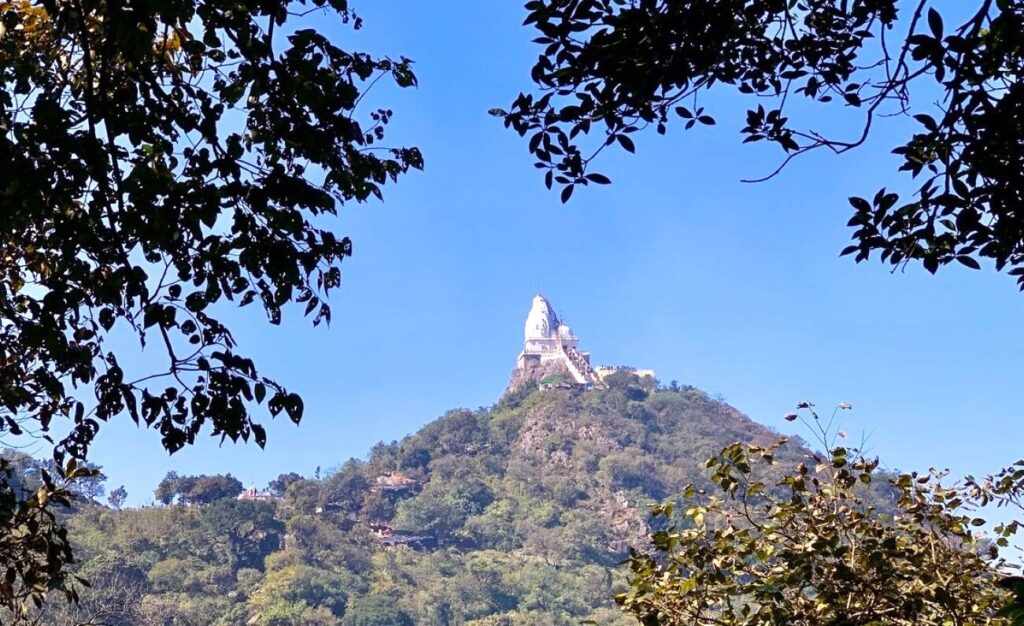Jainism is one of the most ancient religions in the world as depicted in the ancient texts retrieved, deeply rooted in India’s spiritual history. Jains are known for their message of non-violence, truth, and renunciation, Jainism offers a path of self-discipline and liberation. Instead of worshiping a creator God, Jains follow the guidance of the 24 Tirthankaras, enlightened beings who attained omniscience (Keval Gyan) and showed the path to salvation (Moksha). Jainism is the only religion in the world which is now proven by scientists and now proved to be the best way to lead anyone’s life in the current era.
Among Jain holy places, Sammed Shikharji holds the highest sanctity. Located on the Parasnath Hills of Jharkhand, this sacred site is where 20 out of 24 Tirthankaras attained Nirvana, making it the holiest pilgrimage for Jains. Nirvana means the attainment of the highest order of the Soul to be free from the circle of life . For centuries, devotees have undertaken the arduous 27 km trek barefoot, driven by faith, devotion, and the desire for spiritual purity. The yatra is considered to be the gateway to Moksha or Nirvana as 20 of the Tirthankaras attained the same from that place.
This blog explores the origins and evolution of Jainism, the sacred legends of Sammed Shikharji, and its continuing importance in modern times.
Origins of Jainism
Jainism is a non-theistic religion, meaning it does not believe in a creator God. Instead, it teaches that the universe has always existed and operates on its own laws. These laws are governed by the principles of the universe. The focus is on personal spiritual development and liberation from the cycle of birth and death (Samsara).
- The first Tirthankara, Lord Rishabhdev (Adinath) or Bhagwan Adinatha, is believed to have lived in prehistoric times. He taught humanity agriculture, commerce, and social order.
- The 24th Tirthankara, Lord Mahavira (599–527 BCE), is historically recognized. Born as Vardhamana, he renounced worldly life at 30, attained omniscience after 12 years of penance, and spent the rest of his life spreading Jain philosophy. Though Jainism was found by the Lord Adinath but never was actually written into scripts for other natives. Lord Mahavira or Bhagwan Mahavira took that step to spread the learning to the people.
Core Principles of Jainism
The religion is based on the five great vows (Mahavratas):
- Ahimsa (Non-violence): Absolute non-harm to all living beings.
- Satya (Truth): Always speaking the truth.
- Asteya (Non-stealing): Not taking anything without permission.
- Brahmacharya (Celibacy/Chastity): Control over desires and indulgences.
- Aparigraha (Non-possessiveness): Detachment from material possessions.
These vows form the foundation of Jain ethics and guide both monks and lay followers toward purity of mind, speech, and action.
Evolution of Jainism Through the Ages
Prehistoric and Early Period
Archaeological discoveries in the Indus Valley Civilization suggest symbols of asceticism that may be linked to early Jain practices. Jainism existed alongside or even before the Vedic tradition, emphasizing non-ritualistic spirituality.
Mauryan Era
Chandragupta Maurya, founder of the Maurya Empire, embraced Jainism in his later years under Acharya Bhadrabahu. He migrated to Shravanabelagola, Karnataka, where he performed Sallekhana (ritual fast until death), an act of supreme renunciation.
Kalinga and Post-Mauryan Kings
King Kharavela of Kalinga (1st century BCE) was a devout Jain patron who promoted temple construction and supported monks. His Hathigumpha inscription records Jain influence in ancient Odisha.
Medieval Expansion
From the 9th to 12th centuries, Jainism flourished in Gujarat, Rajasthan, and Karnataka. This period produced architectural marvels such as the Dilwara Temples (Mount Abu), Ranakpur Temple, and Shravanabelagola statues. Jain scholars like Hemachandra enriched Indian philosophy, grammar, and mathematics.
Modern Times
Today, Jains are a minority community but highly influential in business, education, and philanthropy. Their principles of vegetarianism and non-violence resonate globally, inspiring environmental and animal rights movements.
Sects within Jainism
Over time, Jainism developed into two major sects:
- Shwetambar (White-clad): Monks wear white clothes, emphasize compassion, and believe women can attain Moksha.
- Digambar (Sky-clad): Monks renounce clothing, symbolizing supreme detachment, and believe women must be reborn as men to achieve Moksha.
Despite differences, both sects equally revere Sammed Shikharji, making it a unifying pilgrimage for all Jains.
Sammed Shikharji: The Holiest Jain Pilgrimage

Situated in Giridih district of Jharkhand, Sammed Shikharji rises majestically on the Parasnath Hills, the highest peak in the state (1,350 meters). The name “Sammed” means “attaining” and “Shikhar” means “peak,” symbolizing the supreme attainment of liberation.
Why is Sammed Shikharji Sacred?
- 20 of 24 Tirthankaras, including Lord Parshvanath (23rd Tirthankara), achieved Moksha here through meditation and penance.
- It is a place of unity, equally sacred to both Shwetambar and Digambar Jain sects.
- It represents the final stage of spiritual evolution, making it the most important pilgrimage site in Jainism.
- The place is spiritual and elevates a person to understand the correct path of life.
According to Jain belief, visiting Shikharji purifies the soul and brings it closer to liberation.
Historical Significance of Sammed Shikharji
Sammed Shikharji has been mentioned in Jain scriptures such as the Kalpasutra, Nishitha Sutra, and medieval commentaries, confirming its sanctity since ancient times.
- Unbroken Tradition: Pilgrimage to Shikharji has continued for thousands of years, making it one of the oldest living pilgrimages in the world.
- Sectarian Harmony: Both Shwetambar and Digambar communities consider Shikharji central to their faith, performing rituals together.
- Pilgrim Accounts: Historical records from Jain monks and lay devotees mention journeys to Shikharji as acts of supreme devotion.
Architecture and Sacred Sites at Sammed Shikharji
The pilgrimage route covers 27 km of mountainous terrain with shrines and temples dedicated to each Tirthankara who attained Moksha there.
Tonk Temples
Each Tirthankara’s liberation site is marked by a Tonk (shrine), where devotees offer prayers. There are 20 Tonks in total, spread across the hill.
Footprints (Charan Padukas)
Sacred footprints symbolize the presence of Tirthankaras, reminding pilgrims of their spiritual victories.
Temple Architecture
- Ancient Temples: Simple stone structures emphasizing asceticism.
- Modern Temples: White marble temples built by Jain trusts and devotees, reflecting grandeur and devotion.
- Main Temple: Located at the Parasnath peak, dedicated to Lord Parshvanath.
The atmosphere of the hill—mist, forests, and chanting of prayers—creates a deeply spiritual experience.
The Pilgrimage Experience
For Jains, undertaking the Parikrama (circumambulation) of Sammed Shikharji is considered the most meritorious act.
- The Trek: A rigorous 27 km barefoot journey, often completed within a day. Some devotees even fast during the trek.
- Rituals: At each shrine, devotees perform puja, chant mantras, and offer rice, sandalwood, and flowers.
- Discipline: Pilgrims maintain silence or recite prayers throughout, focusing on spiritual upliftment.
- Community Bonding: Thousands of pilgrims from India and abroad gather, creating a sense of unity and shared devotion.
- Purity: Devottes wear fresh, new clothes majorly white colored to keep the place clean of any human dirt.
This pilgrimage is not just physical—it is a test of patience, endurance, and inner strength, symbolizing the soul’s journey toward liberation.
Legends and Stories of Sammed Shikharji
Sammed Shikharji is woven with sacred stories:
- Lord Parshvanath’s Nirvana: The 23rd Tirthankara, after years of penance, attained Moksha here. His shrine is the most visited on the hill.
- Other Tirthankaras: From the 3rd Tirthankara, Sambhavanath, to the 22nd, Neminath, most achieved liberation at this holy hill.
- Symbol of Renunciation: Stories describe how monks renounced worldly attachments here before attaining salvation.
These legends reinforce the hill’s role as a gateway to eternal freedom.
Modern-Day Sammed Shikharji
Infrastructure for Pilgrims
The site has Dharamshalas, Bhojnalayas (dining halls), and rest houses maintained by Jain trusts for the convenience of pilgrims.
Conservation Efforts
- Jains worldwide have opposed commercialization and demand recognition of Shikharji purely as a religious site.
- In 2023, nationwide protests forced the government to withdraw its plan to turn Shikharji into a tourist destination, acknowledging its sanctity.
Global Appeal
Jains from countries like the USA, UK, Australia, and Singapore frequently visit, making Shikharji an international spiritual hub, which is done through Vardhman Vacations’ decades of devoted service to facilitate smooth and safe yatra.
Cultural and Social Impact
Sammed Shikharji is not just a pilgrimage—it plays a key role in shaping Jain culture:
- Symbol of Unity: Shwetambars and Digambars perform rituals together.
- Economic Impact: Supports local communities through pilgrimage-based livelihoods.
- Spiritual Identity: Reinforces Jain values of renunciation, peace, and non-violence.
Environmental Significance
The Parasnath Hills are home to dense forests, wildlife, and rare medicinal plants. Protecting the sanctity of Shikharji also helps conserve this ecological treasure. Jain communities actively advocate for eco-friendly practices, such as avoiding plastic and preserving greenery.
Importance of Sammed Shikharji in Jain Devotion
Sammed Shikharji symbolizes the ultimate goal of Jainism—liberation from the cycle of rebirth.
- Spiritual Duty: Every Jain aspires to complete this pilgrimage at least once a year.
- Festivals & Rituals: Special pilgrimages are organized during Paryushan and other Jain festivals.
- Symbol of Unity: Both sects worship here together, reinforcing Jainism’s universal essence.
- Global Inspiration: For Jains abroad, Shikharji serves as a spiritual anchor connecting them to their roots.
FAQ’s About Sammed Shikharji
Sammed Shikharji is where 20 of the 24 Jain Tirthankaras attained moksha. It has been revered since ancient times and continues to be the holiest pilgrimage for Jains.
From Sambhavanath (3rd Tirthankara) to Parshvanath (23rd Tirthankara), except Lord Neminath and Lord Mahavira, attained nirvana here.
Because it is the site of ultimate liberation for most Tirthankaras, making it central to Jain faith and practice.
The Parikrama is around 27 km, usually completed barefoot by devotees in a single day.
The trek is 27 km long and requires physical endurance, but pilgrims undertake it barefoot as a mark of devotion.
The ideal time is between October to March, when the weather is pleasant for trekking.
Yes, people of all faiths are welcome to visit, though rituals are performed by Jains.







